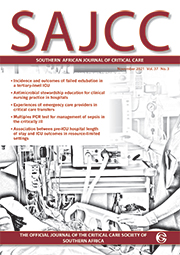Articles

An observational study on the relationship between plasma vitamin C, blood glucose, oxidative stress, endothelial dysfunction and outcome in patients with septic shock
Abstract
Background. Septic shock is associated with endothelial dysfunction and oxidative stress, against which vitamin C plays a protective role, possibly
influencing clinical outcome. Hyperglycaemia may lower vitamin C.
Objective. To study plasma vitamin C, oxidative stress, hyperglycaemia, endothelial dysfunction and outcome in septic shock.
Methods. In a prospective, observational study of 25 adult septic shock patients, serial blood samples were analysed for vitamin C, thiobarbituric
acid-reactive substances (TBARS) (a biomarker of oxidative stress), and soluble vascular cell adhesion molecule-1 (sVCAM-1) and E-selectin
(markers of endothelial dysfunction). Blood glucose, Sequential Organ Failure Assessment (SOFA) scores and fluid requirements were monitored.
Results. Plasma vitamin C was low, while plasma TBARS were high throughout the 7-day study period. Endothelial dysfunction markers (sVCAM-1
and E-selectin) were high at the baseline. VCAM-1 decreased significantly on day 1 and normalised on day 7. E-selectin was unchanged on day 1
compared with baseline, but increased significantly on day 7. Oxidative stress and endothelial dysfunction were associated with increased SOFA
score. Increased oxidative stress was associated with increased requirements for intravenous fluids and prolonged duration of vasoconstrictor
support. Nine patients died in hospital. At baseline, levels of TBARS were significantly higher in non-survivors than in the survivors of septic shock.
Conclusion. In septic shock, clinically relevant oxidative stress was associated with endothelial dysfunction, low vitamin C and high glucoseto-
vitamin-C ratios. Markers of oxidative stress and endothelial damage were increased and correlated with resuscitation fluid requirements,
vasoconstrictor use, organ failure and mortality.
Authors' affiliations
Kondwani George Happy Katundu, Division of Human Nutrition, Department of Human Biology, Faculty of Health Sciences, University of Cape Town, South Africa
Lauren T Hill, Division of Critical Care, Department of Surgery, Faculty of Health Sciences, University of Cape Town, South Africa
Lester M Davids, Redox Laboratory, Department of Human Biology, Faculty of Health Sciences, University of Cape Town, South Africa
Ivan A Joubert, Division of Critical Care, Department of Anaesthesia, Faculty of Health Sciences, University of Cape Town, South Africa
Malcolm G A Miller, Division of Critical Care, Department of Anaesthesia, Faculty of Health Sciences, University of Cape Town, South Africa
Jenna L Piercy, Division of Critical Care, Department of Anaesthesia, Faculty of Health Sciences, University of Cape Town, South Africa
William L Michelle, Division of Critical Care, Department of Surgery, Faculty of Health Sciences, University of Cape Town, South Africa
Full Text
Keywords
Cite this article
Article History
Date published: 2016-07-26
Article Views
Full text views: 1540




1.jpg)
Comments on this article
*Read our policy for posting comments here